Easy Filipino Lumpia Recipe: Crispy Homemade Spring Rolls
Crispy, golden lumpia rolls bring a burst of flavor that dances across your palate with authentic Filipino charm.
Delicate wrappers cradle a savory mixture of ground pork, vegetables, and aromatic spices.
Generations of home cooks have perfected this beloved street food classic in kitchens throughout the Philippines.
Each bite tells a story of culinary tradition and family memories.
Manila’s vibrant food culture shines through these delectable parcels of pure deliciousness.
Wrapping and frying these little treasures requires skill, but the result is worth every careful moment.
Let you embark on a mouthwatering journey that promises to transport you straight to the bustling markets of manila.
Crispy Pork Spring Rolls: Crunchy Highlights
Pork Spring Rolls: All the Fixings
Main Ingredients:Aromatics and Seasonings:Binding Ingredients:Fast Track to Pork Spring Rolls
Step 1: Prep Wrapper Magic
Slice square wrappers into neat rectangles.
Keep wrappers moist by draping a slightly damp kitchen towel over them to prevent drying out.
Step 2: Create Flavor-Packed Filling
Combine all filling ingredients in a large mixing bowl:Mix thoroughly until ingredients are evenly distributed.
Step 3: Craft Rolling Technique
Position wrapper with short edge facing you.
Scoop a generous spoonful of filling near the edge closest to you.
Step 4: Perfect Wrapper Sealing
Fold bottom edge over filling.
Tuck sides inward.
Roll upward smoothly.
Moisten final edge with water to create a secure seal.
Continue rolling completely.
Step 5: Prepare Sizzling Oil Bath
Pour vegetable oil into a deep skillet, creating about half-inch depth.
Heat over medium-high temperature until oil shimmers.
Step 6: Golden Frying Process
Carefully slide spring rolls into hot oil.
Fry until exterior turns golden brown and crispy, rotating occasionally.
Cook for 3-5 minutes.
Step 7: Serve and Enjoy
Transfer crispy spring rolls onto paper towels to drain excess oil.
Plate alongside sweet and sour dipping sauce.
Serve immediately while hot and crunchy.
Pork Roll Tips for Crispy Results
Spring Roll: Fun Fillings to Try
How to Serve Pork Spring Rolls
Spring Roll Storage Know-How
FAQs
Ground pork with some fat content works best, as it provides moisture and flavor to the filling.
Yes, you can prepare and assemble the rolls in advance, then refrigerate them uncooked for up to 24 hours before frying.
Drain excess moisture from cabbage by salting and squeezing it, and ensure oil is hot enough before frying to create a crispy exterior.
Roll slowly and tightly, tucking in edges as you go, and use water to seal the final edge to prevent unraveling during frying.
Print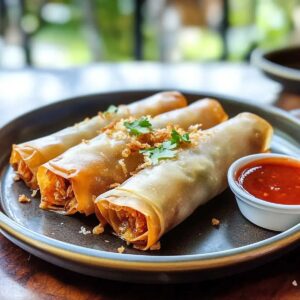
Filipino Lumpia Recipe
- Total Time: 34 minutes
- Yield: 25 1x
Description
Crispy Filipino Lumpia rolls deliver a delightful explosion of savory flavors wrapped in golden, paper-thin wrappers. Packed with seasoned ground pork and fresh vegetables, these delectable appetizers bring Philippine street food magic straight to your kitchen.
Ingredients
Main Protein:
- 2 pounds (907 grams) ground pork
Aromatics and Herbs:
- 5 cloves garlic, minced
- 1 inch ginger, minced
Seasonings and Binding Ingredients:
- 3 tablespoons soy sauce
- 1/2 teaspoon black pepper
- 2 eggs, beaten
- 1/2 teaspoon chicken bouillon powder (optional)
Vegetables:
- 6 ounces (170 grams) cabbage, thinly sliced
Wrappers and Frying Medium:
- 1 package (25) lumpia wrappers
- Vegetable oil for frying
Instructions
- Transform wonton wrappers by slicing them diagonally into triangular shapes, then shield the delicate pieces under a moisture-laden cloth to prevent drying.
- Craft a robust filling by thoroughly blending ground pork with finely chopped cabbage, minced garlic, grated ginger, umami-rich soy sauce, savory bouillon, whisked eggs, and cracked black pepper until ingredients are evenly distributed.
- Position each wrapper with its narrow side facing towards you, then strategically place a generous spoonful of the seasoned mixture near the closest edge, ensuring a compact foundation.
- Carefully encase the filling by folding the wrapper’s bottom edge over the mixture, tucking and compressing to create a tight cylinder, leaving a small margin at the top.
- Seal the spring roll’s edge by dabbing water along the exposed wrapper, then complete the rolling process, pressing gently to secure the seam and prevent unraveling during cooking.
- Prepare a deep skillet with approximately half an inch of vegetable oil, heating to 350°F over medium-high flame until the surface shimmers with consistent warmth.
- Gently lower the assembled rolls into the hot oil, maintaining a golden-brown transformation for 3-4 minutes, rotating occasionally to ensure uniform crispiness and even coloration.
- Transfer the freshly fried spring rolls onto a wire rack or paper towel-lined plate to drain excess oil, then serve immediately alongside a vibrant sweet and sour dipping sauce.
Notes
- Use thin rice paper or spring roll wrappers for extra crispiness and lighter texture.
- Pat cabbage and meat dry to prevent soggy spring rolls and ensure maximum crunchiness.
- Replace pork with tofu, mushrooms, or mixed vegetables for a plant-based alternative that maintains similar flavor profile.
- Keep oil consistently around 350-375°F to achieve golden-brown exterior without burning or absorbing excess oil.
- Prep Time: 30 minutes
- Cook Time: 4 minutes
- Category: Appetizer, Snacks
- Method: Frying
- Cuisine: Filipino
Nutrition
- Serving Size: 25
- Calories: 212
- Sugar: 0.4 g
- Sodium: 310 mg
- Fat: 13 g
- Saturated Fat: 4 g
- Unsaturated Fat: 8 g
- Trans Fat: 0 g
- Carbohydrates: 11 g
- Fiber: 1 g
- Protein: 11 g
- Cholesterol: 55 mg

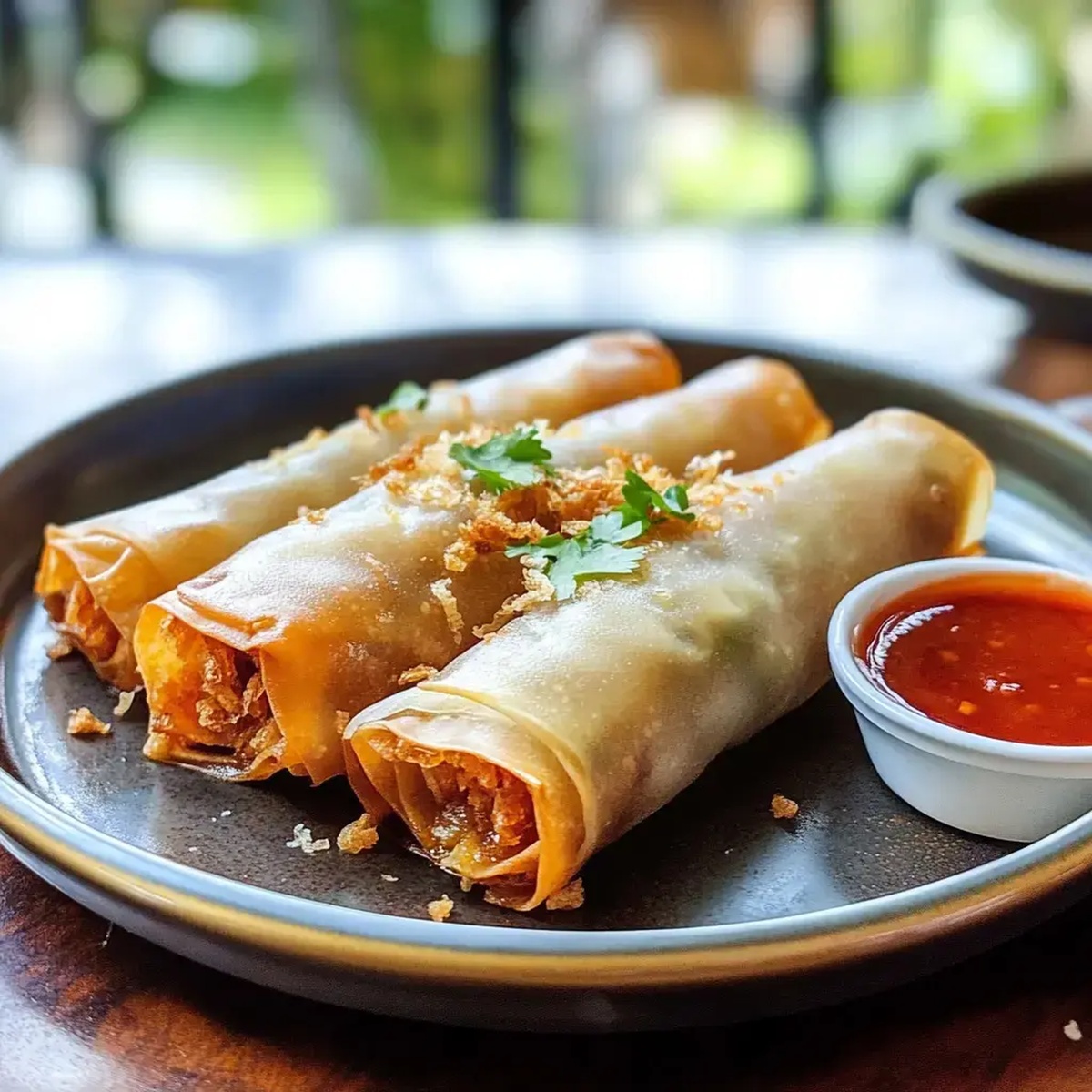
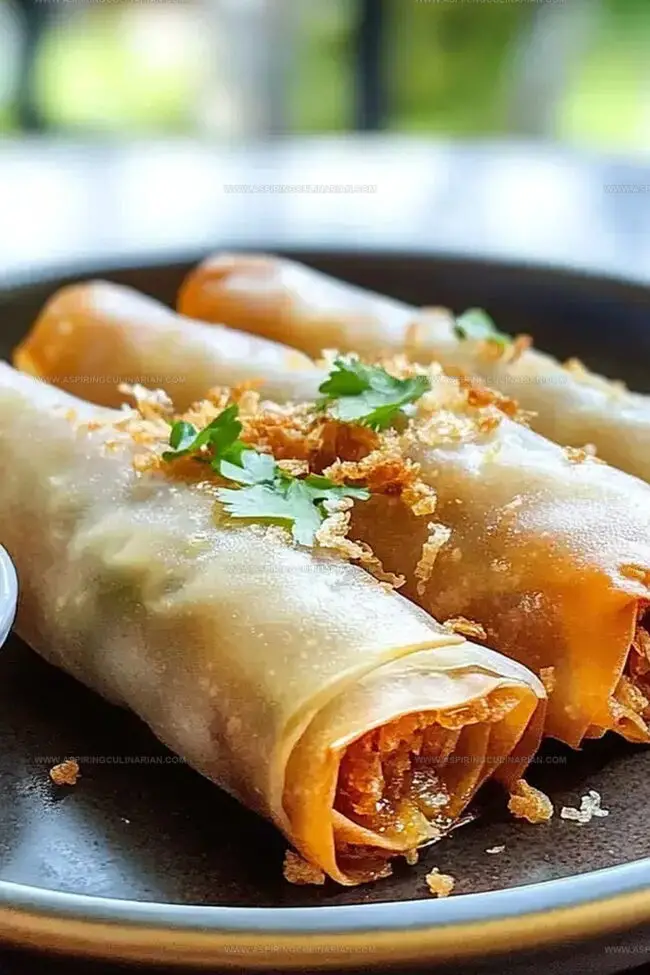
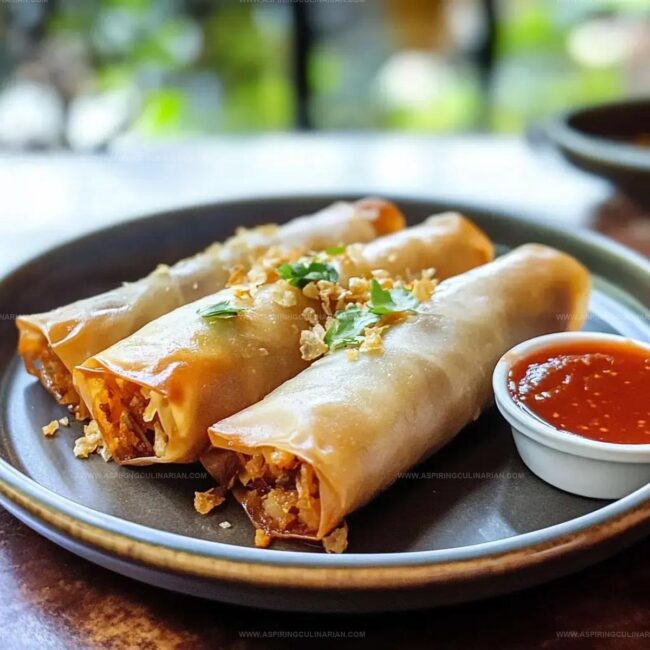
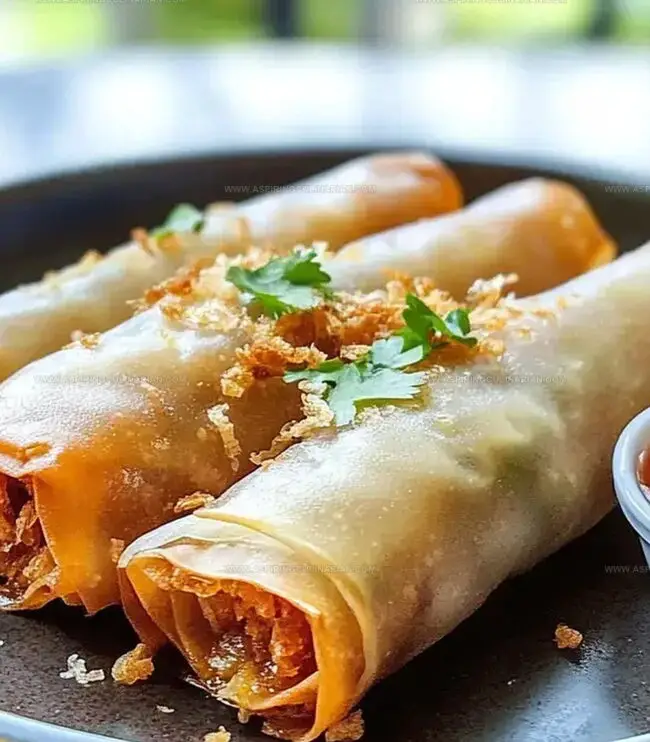
Nathaniel Brooks
Founder & Recipe Developer
Expertise
Farm-to-table cuisine, Seasonal recipe development, Culinary storytelling
Education
Ivy Tech Community College – Indianapolis, IN
Culinary Arts / Hospitality Administration & Events
Focused on hands-on training in classical and modern culinary techniques.
Nathaniel’s story starts in the foothills of the Appalachian Mountains, where farm stands, backyard gardens, and old family recipes shaped his love for real food. After graduating from Ivy Tech Community College in Indianapolis, he spent years working in farm-to-table kitchens, learning how to turn local, seasonal ingredients into something memorable.
Today, Nathaniel pours that same spirit into every single recipe on Aspiring Culinarian – recipes that feel real, comforting, and connected to the land. When he’s not in the kitchen, you’ll find him foraging wild herbs, chasing sunsets with his camera, or writing about the flavors that shaped his roots.